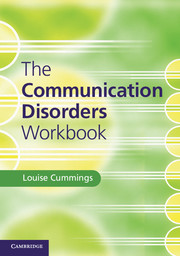Book contents
- Frontmatter
- Contents
- Preface
- Acknowledgements
- List of data analysis exercises
- Chapter 1 Introduction to communication disorders
- Chapter 2 Developmental speech disorders
- Chapter 3 Developmental language disorders
- Chapter 4 Communication disorders in mental illness
- Chapter 5 Acquired speech disorders
- Chapter 6 Acquired language disorders
- Chapter 7 Disorders of voice
- Chapter 8 Disorders of fluency
- Chapter 9 Hearing disorders
- Answers to questions and exercises
- Glossary
- References
- Index
- References
Chapter 7 - Disorders of voice
Published online by Cambridge University Press: 05 June 2014
- Frontmatter
- Contents
- Preface
- Acknowledgements
- List of data analysis exercises
- Chapter 1 Introduction to communication disorders
- Chapter 2 Developmental speech disorders
- Chapter 3 Developmental language disorders
- Chapter 4 Communication disorders in mental illness
- Chapter 5 Acquired speech disorders
- Chapter 6 Acquired language disorders
- Chapter 7 Disorders of voice
- Chapter 8 Disorders of fluency
- Chapter 9 Hearing disorders
- Answers to questions and exercises
- Glossary
- References
- Index
- References
Summary
A significant number of children and adults experience problems with the production of voice or phonation which compromise their effectiveness as communicators. Many voice disorders or dysphonias have an identifiable organic aetiology. This may take the form of benign growths known as vocal nodules, which are related to sustained vocal abuse. Unsurprisingly, vocal nodules are commonly found in children who regularly shout and scream and in professional voice users (e.g. singers) who place above average demands on their voice. Alternatively, a malignant growth may pervade the tissues of the larynx to such an extent that a partial or complete laryngectomy is necessitated. The adult who undergoes a laryngectomy can achieve voice production after surgery through the use of an artificial or electronic larynx, the production of oesophageal voice or surgical voice reconstruction. Aside from benign and malignant growths, other organic aetiologies of voice disorders include infections (e.g. viral laryngitis), neurological impairment (e.g. vocal fold paralysis), vocal fold haemorrhage, and laryngeal trauma (e.g. as a result of endotracheal intubation). Speech and language therapists work closely with ENT specialists (or otolaryngologists) in the assessment and treatment of organic voice disorders.
In a significant number of clients, voice disorders occur in the absence of an identifiable organic aetiology. So-called functional or psychogenic voice disorders include conditions such as puberphonia (primarily in adolescent males) and conversion aphonia which can arise in response to a significant psychological trauma. Owing to the presence of psychological factors in the development and maintenance of functional voice disorders, speech and language therapists often work closely with clinical psychologists and psychiatrists in the assessment and treatment of these dysphonias. In reality, however, most voice disorders have organic and psychological components. For example, an adult may routinely engage in hyperadduction of the vocal folds in response to various psychological stressors. However, this pattern of voice use may damage the vocal fold mucosa and lead ultimately to the development of vocal nodules. In this case, the client's voice disorder has clear psychological and organic components within its aetiology.
- Type
- Chapter
- Information
- The Communication Disorders Workbook , pp. 111 - 124Publisher: Cambridge University PressPrint publication year: 2014



